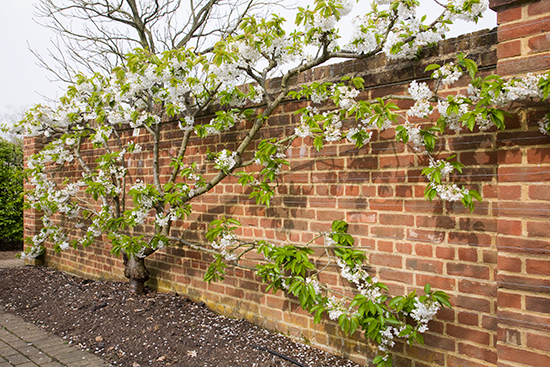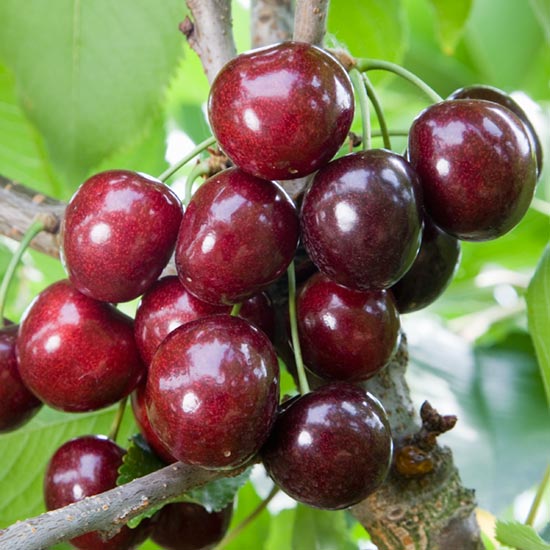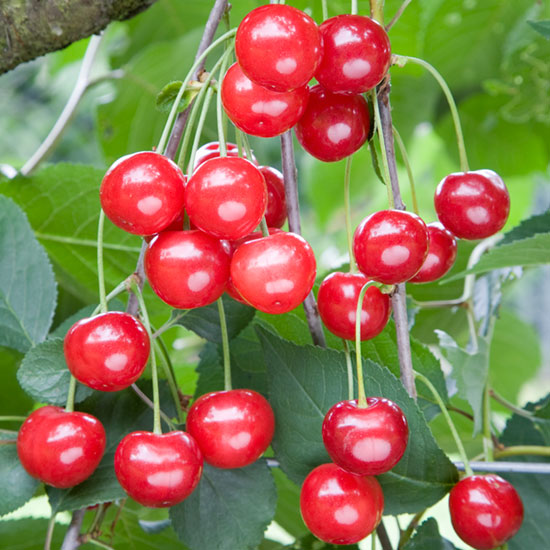Not so long ago the thought of growing cherries in the garden or allotment other than as one big tree was simply a fantasy. Likewise, commercial cherry growers were finding life very difficult with their orchards of big trees and many of them gave up. Large swathes of the UK simply stopped growing this wonderful fruit. The major problem was the height of the trees which made picking very difficult and expensive as agricultural wages increased, plus the desire of large populations of birds to consume the crops before they could be picked. There were many attempts to produce dwarfing rootstocks in the same manner as had been developed for apples and pears but until the introduction of the Colt rootstock in the 1970’s it was very hard indeed to grow manageable sized cherry trees. This led to new commercial plantings which in turn led on to the release of even more dwarfing rootstocks such as Gisela 5 which is why, that coupled with new breeding programmes, English cherries are being more widely grown again. So there is now really no need to avoid growing cherries in the garden or allotment.
There are two main types of cherry – acid and sweet. The good thing about acid cherries – and Morello is the best known – is that they will put up with quite shady positions and are ideal for growing as fans against north facing walls and fences. The fruits can be very sour but are perfect for cooking and making jams and have the bonus of generally being ignored by birds who don’t seem to like acid cherries to eat! Another bonus is that all acid cherries are self-fertile so will not need a pollinator. There are also a few “Duke” cherries which are a cross between sweet and sour cherries. These cherries, whilst a little more sensitive to frost than sour cherries, can be grown on north facing walls and produce some fairly sweet tasting cherries. They are well worth experimenting with if you don’t have access to a warm wall.
Sweet cherries are wonderful and well worth growing and in my opinion are best grown as fans against walls and fences as they are easy to manage in this way and easy to protect against birds. It is also possible to grow sweet cherries as cordons and I have done this on many occasions – these forms are also easy to manage and protect from birds. You can also grow sweet cherries as small bush trees but I don’t think they lend themselves so well to this form of growing. In any case a cherry cordon or fan fruiting well is a very decorative feature during the summer! You have plenty of good varieties to choose from but please note that whilst many are self-fertile, some are not, so you will need to plant a suitable pollinator if you select a variety that is not self-fertile.
It is particularly important that you buy cherry trees from a reputable supplier as you want to ensure that you buy a tree that has not been infected with disease. All stone fruits are liable to infection by Bacterial canker and/or Silverleaf and this is easily contracted if the trees are not looked after before you buy them. Note that cherries flower early in the year so avoid planting in a frost pocket and if frost is forecast, protect the blossom overnight with horticultural fleece or old curtains and remove it during the daytime to allow access to pollinating insects. You can buy ready trained fan trees but it is important to recognise that these will cost considerably more than if you buy a maiden (a one-year-old tree) and develop your own fan tree and in any case it is far more rewarding to train a tree yourself! Likewise, it is very easy to develop a cordon tree from a maiden tree.
Bare root trees can be planted when they are dormant (usually from late November/December until late March/April). Prepare the soil well by removing all weeds and then dig over the soil using well-rotted compost to build up its fertility. When planting use some Fruit Feed or blood, fish and bone in your planting hole and also incorporate some whilst you are backfilling. When planting cherries, as with other stone fruits, do not prune any of the branches unless damage has occurred as there is a higher risk of disease infection when the sap is not flowing. Once buds have opened in the first spring after planting you are then able to cut back any growth that is too long for your fan framework, leaving the major pruning until the summer.
In order to develop your maiden trees into fans or cordons – particularly fans – you will need to undertake formative pruning. Having planted a maiden to develop into a cordon or fan you should seek to undertake the first prune once the buds have burst in early spring when you can safely prune. In the case of fans, if you are starting with a maiden whip (a tree without side branches), cut the leader back to 60cm (2ft). This will promote the development of multiple side shoots. If you are starting with a feathered maiden (a tree with side branches), select three or four well-spaced shoots growing off the main stem about 75cm (2ft 6in) above ground level. These are going to be your main branches and you should shorten them by about two thirds to a bud. Remove all other shoots off the main stem below these branches and cut the leader back to just above the highest branch. By the time you reach the tree’s second spring these main branches will have produced their own side shoots and you will need to prune back the strongest of these by a half. At this time prune out any weak or badly placed shoots and cut back around one in four of the older fruited branches to a new strong shoot to replace the removed branch. Shorten all upright growth that is growing in the centre to a suitable side shoot. In the case of cordons imagine that the cordon’s single stem is the same as a branch of a fan and prune accordingly.
Once you have your trees established and the formative pruning is over you need to consider annual maintenance pruning. The first thing to recognise is that acid, duke and sweet cherries grow differently and pruning techniques need to be planned accordingly. Acid and duke cherries bear the majority of their fruit on the previous year’s growth and the pruning aim is to achieve a balance between one-year-old fruiting wood and new replacement branches and this is known as replacement pruning. Sweet cherries fruit on both last year’s and older wood, so pruning is required to ensure a balance between retaining older fruiting wood and establishing younger replacement branches. The second thing to recognise is that this annual pruning takes place as soon as the trees have fruited.
So let’s look at the pruning techniques; the following may sound complicated but I assure you that it is not! Once you have done it once you will find it very easy in following years. I’m going to start with acid and duke cherries first. In the case of fans, cut back each fruited branch, when fully grown, to a new strong shoot and tie that shoot in to your growing framework. This will be the following year’s fruiting wood. Completely remove any shoots that are growing directly into the fence or wall and pinch out to two leaves any other shoot that you have kept but are not able to tie in as yet – they may be too short, growing away from your fence or wall or simply because there is no room. For cordons simply cut back all fruited wood to a new shoot which will develop to fruit the following year.
For sweet cherries the pruning is slightly different as you are seeking to achieve a mixture of new and old wood. Therefore, you are looking to create fruiting spurs off the old wood and replace some of the older wood with new wood. To achieve this with fan cherries tie new shoots in from early summer onwards where there is space to tie them. Completely remove any shoots that are growing directly into the fence or wall as well as any congested growth. Pinch back the new shoots that you tied in to five or six leaves. After fruiting shorten these shoots further to two or three leaves to create a new fruiting spur. You also need to replace a few branches of your fan each year and for this you follow the same rule as for acid cherries i.e. cut a fruited branch back to a new strong shoot and tie that into your framework. For cordons cut half of the fruited wood back to a new shoot but leave some to develop spurs for future years’ fruiting. In this way you should be able to achieve a good fruiting balance.
Once your cherry fruitlets have started forming the trees will benefit from water in times of dry weather, although I prefer to let the trees get on with it or surface roots will develop and this is not good for tree longevity. A handful of Fruit Feed or blood, fish and bone every spring will be beneficial to your trees. Pick your cherries preferably during dry weather, doing so by the stalks, not the body of the fruit, which bruise easily. Eat sweet cherries fresh off the tree but if you have too many for this you can store them in bags or containers in the fridge for a few days. Acid cherries are not suitable for eating fresh but are ideal for cooking with or jam making. With these cherries it is best to either store them in the fridge or to cook them up as soon as they are picked.
Unfortunately, cherry trees are liable to both Bacterial Canker and Silverleaf and it is probably inevitable your trees will eventually suffer from one of these. However, you can radically minimise the chance of this happening by buying your trees from a reputable supplier and not pruning when the sap is not rising. I suggest that you interpret this as not pruning between the end of September until the end of March. Also make sure that you prune cleanly and try not to cut out large branches as the wounds on these take much longer to recover.
Some cherries are very liable to splitting in times of heavy rainfall and this has been addressed commercially by a combination of developing varieties that are less prone to splitting as well as growing them within polythene tunnels or covers. This is why dwarfing rootstocks have become so popular. If you live in an area of heavy rainfall it will be prudent for you to select varieties that are not too prone to splitting unless you can grow them under cover.
Sweet cherry varieties (all are self-fertile unless noted otherwise)
Cherokee is a popular, heavy cropping sweet cherry, the fruits of which turn from dark red to almost black when ripe. This is a good cherry for growing in wet areas as the fruits are less prone to splitting than other varieties.
Colney is a good sweet cherry that has been developed to have some resistance to Bacterial Canker. The fruits are almost black when ripe. This variety is not self-fertile so will need a pollinator.
Kordia is a heavy cropping black sweet cherry which has large fruits with a red flesh. This is another variety which is less prone to splitting in wet conditions.
Penny is an easy to grow quality sweet cherry. It is very heavy cropping from an early age and produces large, dark red fruits turning to black when ripe. It has some tolerance to wet conditions. This variety is not self-fertile so will need a pollinator.
Stella produces large crops of high quality sweet cherries that turn from red to almost black when ripe. Unfortunately it is fairly prone to splitting, so do not grow it in wet areas unless you can cover it.
Summer Sun is a large, dark red sweet cherry that will grow well in the northern parts of the UK and exposed areas and will crop relatively well in poor summers. It is fairly compact in growth and therefore ideal for small gardens.
Sunburst is a heavy cropping sweet cherry, the fruits of which are almost black when fully ripe. It is considered to be one of the best for storing for a few days after picking.
Sweetheart is a heavy cropping, dark red sweet cherry which will crop and ripen over a very long period and often until the end of September. If you can only grow one sweet cherry this variety may be the one to go for!
Acid cherry varieties
Morello is probably the best acid cherry which will crop well in fairly shady situations and when spring and summer weather conditions have been poor. It is very heavy cropping and the beautiful blossom lights up shady areas in early spring! This is a perfect cherry for cooking with and making jam.
Duke cherry varieties
Meteor Korai is a “Duke” cherry which will tolerate a fair amount of shade. The cherries will be very edible and also good for cooking.
Gerry Edwards
29th March 2016
Gerry is an experienced amateur fruit grower who is Chairman of the RHS Fruit Group, a member of the Royal Horticultural Society’s Fruit, Vegetable and Herb Committee and also their Fruit Trials Panel. Gerry judges fruit nationally for the Royal Horticultural Society and is also a qualified National Vegetable Society judge.




Thankyou so much for all the advice..very interesting and informative. I have been given a ‘sunburst’ Cherry. Do i need to plant a pollinator with it or is it self fertile?
Hi Ali. Sunburst is self-fertile so you do not need a pollinator.
I’m planning a potager garden for next year and would love to grow cherries. Could you tell me if a sweet cherry like Penny can be pollinated by a sour cherry such as morello?
Thanks 🙂
Hi Jenny. Morello will pollinate Penny.
My north facing wall is about 1.80-2m tall and 5-6 m long. Would a morello cherry on colt root stock be too large? Some websites indicate that the colt may be too big but others suggest that the acid Cherry is less vigorous and a 2m wall will be OK…
Hi Eddie
Acid cherries are less vigorous than sweet cherries. You can certainly keep the tree restricted to 1.8-2m in height with summer pruning but in doing so you will be reducing the cropping potential.
Thanks you so much for your posting. I would like to diversify through growing family trees; that is trees with numerous varieties grafted on. I see such commercial examples of Napleon and Vega together on one tree. I wonder if spreading the activity season for a tree tires it out. How sensible is it to combine different varieties, what is the best rootstock/combination (that means including interstems) and does this create unforseen problems by overworking the rootstock?
Hi Robert
Unfortunately we cannot speak definitively on all of these issues. While some fall within our experience, others do not. So there are areas where we can only pass on others comments and opinions.
We know of no commercial fruit grower producing cherries using family cherry trees. This though is mainly because they would not want to confuse their pickers – the fruit market demands single variety shipments and there are differences in ripening times. Challenges are also likely to arise with pruning and balancing growth between multiple varieties so it is a lot simpler to stick to one variety per tree. Pollination is covered by planting different varieties in different rows.
We can see no reason why extending the cropping season by having more than one variety on the same tree should put the tree under any undue stress. However we have been advised that within Prunus (plums, cherries, almonds, apricots, peaches etc) there are significant risks of long-term incompatibility leading to grafts breaking down after say 5 to 10 years. The “Duo” trees widely available with 2 varieties of cherry or plum avoid this by having both varieties grafted directly onto the rootstock, but this is not practical if one wants to add extra varieties in later years (run out of room, trunk too old, too thick etc.)
The only cherry rootstocks we would recommend for home grafting are Colt (semi-dwarf) or the F12/1 selected seedling of Prunus avium, our Common Cherry (vigorous). The modern dwaring rootstocks such as Gisela 5 offer real advantages to the fruit grower – heavier crops in adverse weather and smaller trees so easier to pick, but in the UK they are very difficult to successfully propagate onto, success rates are often below 10%. Fruiting cherry trees on G5 planted in the UK are almost invariably propagated in parts of Europe with longer hotter summers. We have no experience of using interstems with cherries.